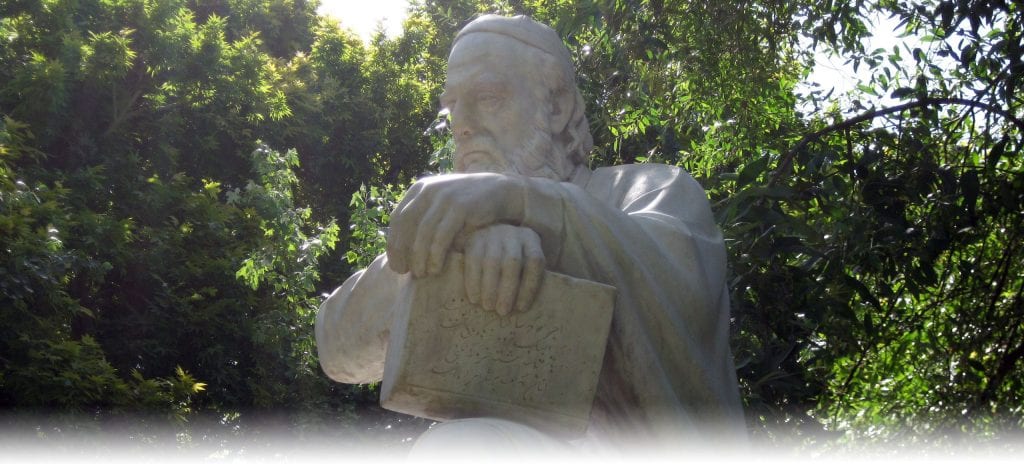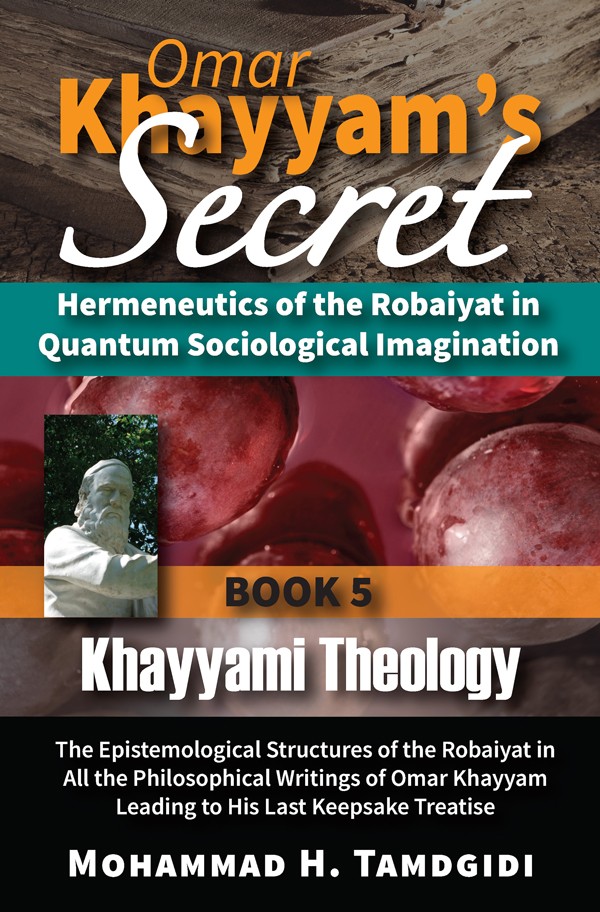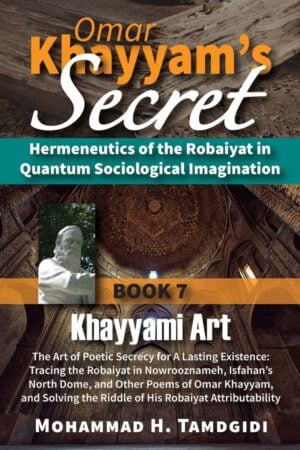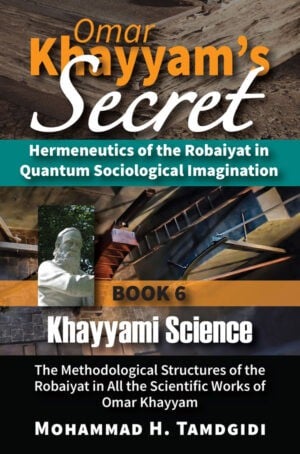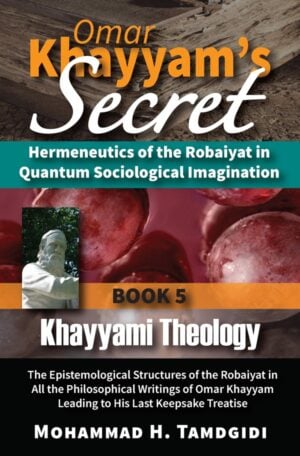Book Section: CHAPTER VI — Omar Khayyam’s Treatise Addressed to Moshkavi in Response to Three Questions on Soul’s Survival, the Necessity of Accidents, and the Nature of Time: The Arabic Manuscript and Updated Persian and New English Translations, Followed by Textual Analysis — by Mohammad H. Tamdgidi
$20.00
This essay titled “Omar Khayyam’s Treatise Addressed to Moshkavi in Response to Three Questions on Soul’s Survival, the Necessity of Accidents, and the Nature of Time: The Arabic Manuscript and Updated Persian and New English Translations, Followed by Textual Analysis” is the sixth chapter of the book Khayyami Theology: The Epistemological Structures of the Robaiyat in All the Philosophical Writings of Omar Khayyam Leading to His Last Keepsake Treatise, which is the fifth volume of the twelve-book series Omar Khayyam’s Secret: Hermeneutics of the Robaiyat in Quantum Sociological Imagination, authored by Mohammad H. Tamdgidi.
Description
Abstract
This essay titled “Omar Khayyam’s Treatise Addressed to Moshkavi in Response to Three Questions on Soul’s Survival, the Necessity of Accidents, and the Nature of Time: The Arabic Manuscript and Updated Persian and New English Translations, Followed by Textual Analysis” is the sixth chapter of the book Khayyami Theology: The Epistemological Structures of the Robaiyat in All the Philosophical Writings of Omar Khayyam Leading to His Last Keepsake Treatise, which is the fifth volume of the twelve-book series Omar Khayyam’s Secret: Hermeneutics of the Robaiyat in Quantum Sociological Imagination, authored by Mohammad H. Tamdgidi.
In this chapter, Tamdgidi offers the Arabic text, an updated Persian translation (benefiting from that offered by Qasem Ansari), and a new English translation of a treatise by Omar Khayyam (AD 1021-1123) generally known as “Response to Three Questions” (جواباً لثلٰث مسائل), addressed to Moshkavi (المشكوى). This treatise by Khayyam is significant both substantively and biographically in terms of the clues it provides regarding Khayyam’s whereabouts at one or another time of his life.
Substantively, the three questions asked from Khayyam have to do with the following. First question: “If rational souls after death, upon its occurrence in the body, survive, given their temporal cause-effect relations they must necessarily have their own specific, individual, and objective existences. Is this a right point of view given such a valid conditional proposition?” Second question: “When possible accidents suddenly occur and their causes can be traced to a necessary existence, does this not invalidate their “possible” nature? How do philosophers view this?” Third question: “What is the proof that the existence of time is due to motion, and its measure depends on the quantity of movement in the sphere, where motion is not subject to its own essence?”
Khayyam provides the most detailed answer to the first question, elaborating less on the second (also important) question since he reports having done so in detail in a treatise he wrote years before addressed to the supreme judge of Fars Abu Taher in the year 473 LH. He provides some thoughts on the last question as well. Following his responses to the three questions, there is an addendum, which seems to be an effort at elaborating more on his answer to the second question (one which he noted he had answered before in a treatise whose copy he says he no longer possesses but can be found in several regions he lists).
From the substance of Khayyam’s answer to the second question, it is clear that the treatise he says he had written back in the year 473 LH is the “Treatise on Existence.” However, since Tamdgidi has already argued and shown in prior chapters of this volume that the three treatises on existence titled “On the Necessity of Contradiction,” “On Existence (on the study of attributes),” and “Treatise on Existent” (known as “The Light of Intellect on the Subject Matter of Universal Science”) were parts of the same series Khayyam addressed to a single person, we can know confidently say that all those three treatises noted above were addressed to Abu Taher, written in the year 473 LH (around AD 1080-1081). Still, since Khayyam refers in the singular to the treatise he wrote in 473 LH, that also suggests our earlier consideration that the three treatises were independently written while being inter-related, as Khayyam’s own notes in his “Treatise on Existence” confirm.
Given the finding reported in this chapter regarding the addressee of this treatise, Moshkavi, having been a Shia intellectual, we have now a reliable basis to offer the hypothesis that Khayyam did have Shia associations and was to an important extent linked to circles of Shia thinkers, though not necessarily to the militant Shia Ismaili sect associated with Hasan Sabbah, even though he takes (in his last keepsake treatise on the universals of existence, one we studied in Book 4 of this series) Ismaili (or Bateni) teaching seriously enough to include it among the four spiritual paths current in his time.
On the basis of new information now available also about Abu Taher (to be confirmed in a later book in the series), the supreme judge of Fars, who died in the year 492 LH, since Khayyam does not address him as a deceased person in this treatise, we can safely assume that the treatise “Response to Three Questions” was written before 492 LH.
Also, since there is no mention of his treatise on the universals of science in the treatise studied in this chapter, we can also safely assume that the treatise was written sometime before 488 LH, when (as we determined in Book 4 of the series) the treatise on the universals of science was written sometime in that year. Tamdgidi offers the date of writing of this treatise to be plausibly 485-488 LH.
One of the most interesting aspects of Khayyam’s answer to the first question in the treatise asked by Moshkavi is the absence of a basically conventional theological answer to the question asked. Following conventional theological arguments, Khayyam could have readily argued for the existence of an afterlife where souls resurrect in their old bodily settings to face judgment.
However, Khayyam’s response is one of questioning the taken for granted, being aware of differences of opinion existing on the topic, and subjecting the seemingly theological question to mathematical considerations and doubting of conventional wisdom.
Khayyam’s effort in trying to answer the questions posed to him, especially regarding the first question, is highly significant in the sense that it represents a view on his part that even questions of human life and death, survival and salvation, can and should be explored in a this-worldly way, including mathematical interpretations and solutions.
In Tamdgidi’s view such an approach is most illustrative of Khayyam’s what we would today call “transdisciplinary” mode of exploring problems that may seem odd to us because of the way we in modern times have become conditioned in dividing our knowledges into disciplines, treating spiritual questions as being separate from mathematics and numbers.
As evident in his writings already examined, Khayyam believed in the existence of a Necessary Being, God, who is beyond the universe created by Him. So, the notion of spiritual (self-reflective intellects) being able to exist and survive independently of the body cannot be, as a matter of logical reasoning, unacceptable to him.
Yet, he seeks his answers about the survivability of soul in relation to body not in the framework of an “other world” but in relation to the finitude and infinitude confronting us in a this-worldly context. Therefore, his consideration of a “future salvation” (to which the notion of “akherat” or آخرت usually refers theologically) are tackled in his answers in a this-worldly context rather than initiating and conducting a discourse on what will happen in “another world.”
Khayyam reveals while answering the second question in the treatise that sometime before writing it, he was afflicted with a serious illness from which he was then recovering, one that had impaired and limited to some extent his speech and handwriting. Given his sincerity and appreciative intimacy with the addressee of the treatise, Moshkavi, it does not seem likely that he was simply using illness as an excuse not to write more.
However, his account gives the impression that he was on his way to recovery, and we know that, given he lived much longer and wrote (or dictated) his last most important treatise in Persian “Treatise on the Universals of Existence” not too long after this treatise on three questions, he must have recovered from the illness and lived to die a 102 solar years old centenarian in 517 LH (AD 1123).
Khayyam’s reference to “brothers,” clearly indicates that he regarded the Shia Moshkavi as being intellectually mature and senior enough to be referred to as Sheikh ol-Rais, and to be supported spiritually and even materially by him along with brothers that he assumes he shares with Moshkavi. Khayyam was therefore both supported by, and in turn himself supported and engaged with, the Shia intellectuals, to the extent of having ongoing, open-minded, and frank philosophical discussions with them.
This finding renders this treatise by Khayyam as an important biographical tract for understanding his life in its social and historical contexts. The obscurity of the names of persons Khayyam was corresponding with suggests that contrary to common belief, his life was not merely a public one associated with the minister and king(s) of the time, but one (also) in which he pursued associations with diverse communities of thinking and spirituality on the margins of apparent power circles.
In response to Moshkavi’s second question, Khayyam offers a new and insightful re-elaboration of how one should approach the question of distinguishing between necessary and possible existents, a perspective which fully takes into account the process of knowing and such attributions in terms of the participation of the observer in what is observed.
The fact that human consciousness and “consideration” is brought into the analytical effort epistemologically is not accidental, but arises from the ontological architecture of a universe whose succession order necessarily, structurally, leads to the coming into being of intelligent species such as the humankind, endowed with the capacity for being thoughtful and reflective (or not), of considering (or not), the causes of events that take place seemingly accidentally.
Khayyam frames his answer to the third question around the viewpoint that spheres, their motions, and time, are created phenomena and not self-existing, eternal things—created by God, who Himself, as we further read in his answer, stands outside time and place.
He also rejects the views of those who seek to disprove the existence of time and motion simply by speculating on the possibility that we could subjectively regard them as being impossible to exist. So, he avoids a solipsistic view of the subject that goes to the extreme of considering the impossibility of existence of time and motion simply because we may imagine them to be impossible to exist.
The treatise by Khayyam addressing Moshkavi’s three questions should be considered as one of the highly illuminating and important accounts of his works, especially in revealing his theological epistemology. He turns his answers to substantive questions asked by Moshkavi into discourses on logic and method.
From his answer to the first question, especially, we learn that Khayyam was seriously inclined toward a non-atomistic worldview, citing many of his predecessors in both Greek and Moʿtazeli Islamic tradition in suggesting that all things are infinitely divisible. Not only he applies the same view to material things, but even in social and human life, he notes that any single individual is an ensemble of infinite individuals, practically offering not an atomistic, but a dialectical view of how things related to one another as being superposed with one another.
His argument is also informed by an epistemological approach that is always mindful of the role our own symbolic language and subjective world play in even formulating logical syllogisms and propositions.
Finally, and again, we should also note it as important and interesting that Khayyam often and continually reminds his addressee that God is a just God, and one that is “Higher and Greater than anything oppressors say.” There is no doubt that Khayyam believed in God, and regarded Islam as a spirituality for which justice against all oppression is of the essence.
Recommended Citation
Tamdgidi, Mohammad H. 2022. “CHAPTER VI — Omar Khayyam’s Treatise Addressed to Moshkavi in Response to Three Questions on Soul’s Survival, the Necessity of Accidents, and the Nature of Time: The Arabic Manuscript and Updated Persian and New English Translations, Followed by Textual Analysis.” Pp. 347-408 in Omar Khayyam’s Secret: Hermeneutics of the Robaiyat in Quantum Sociological Imagination: Book 5: Khayyami Theology: The Epistemological Structures of the Robaiyat in All the Philosophical Writings of Omar Khayyam Leading to His Last Keepsake Treatise. (Human Architecture: Journal of the Sociology of Self-Knowledge: Vol. XVIII, 2022. Tayyebeh Series in East-West Research and Translation.) Belmont, MA: Okcir Press.
Where to Purchase Complete Book: The various editions of the volume of which this Book Section is a part can be ordered from the Okcir Store and all major online bookstores worldwide (such as Amazon, Barnes&Noble, Google Play, and others).
The Robaiyat of Omar Khayyam has also been referred to as “Rubaiyat of Omar Khayyam” (in Persianرباعيات حكيم عمر خيام نيشابوري) using an alternative transliteration from the Persian (or Arabic).
